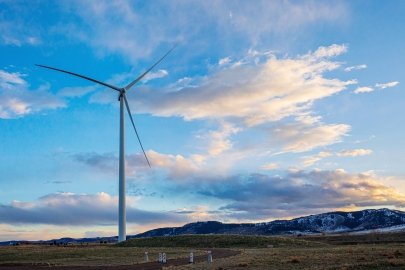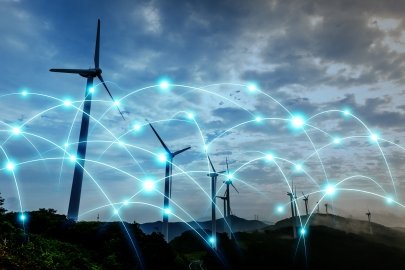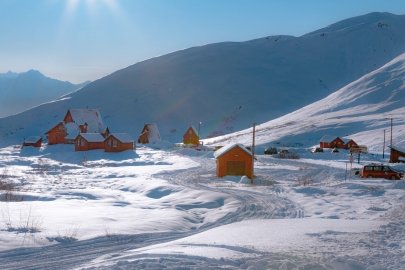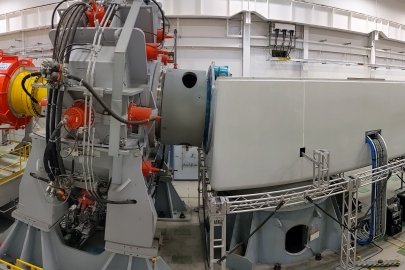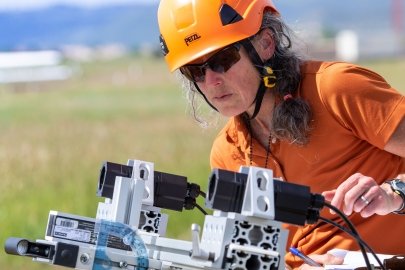The Pacific Northwest National Laboratory reviewed studies that focused on the technical evaluation of offshore wind energy transmission through potential points of interconnection along the coastlines of California, Oregon, and Washington.
Wind Energy Technologies Office
May 17, 2023This article is part of the
SPRING 2023 R&D NEWSLETTER
In This Issue
Off the nation’s coasts, about two-thirds of offshore wind energy potential exists over waters too deep for today’s fixed-bottom wind turbine foundations. Instead, floating turbine platforms are needed to harness the high winds blowing above these deep seas.
The U.S. Department of the Interior’s Bureau of Ocean Energy Management (BOEM) has set a goal of deploying 15 gigawatts of floating offshore wind by 2035, and much of this development is likely to happen off the West Coast, where almost all areas are deep and require floating platforms. Building offshore wind off the Western United States, of course, also requires a plan to bring that power onshore to American homes and businesses.
There have been several studies focusing on the interconnection and transmission of offshore wind energy in the nation’s Western Interconnection, covering different temporal and geographical scales. Other studies have also modeled the cost of offshore wind grid impacts on the Western Interconnection. However, no comprehensive efforts have been undertaken to review these studies and identify gaps from a whole system perspective—until now. The West Coast Offshore Wind Transmission Literature Review and Gaps Analysis was launched in 2022 with funding from the U.S. Department of Energy’s (DOE) Wind Energy Technologies Office (WETO).
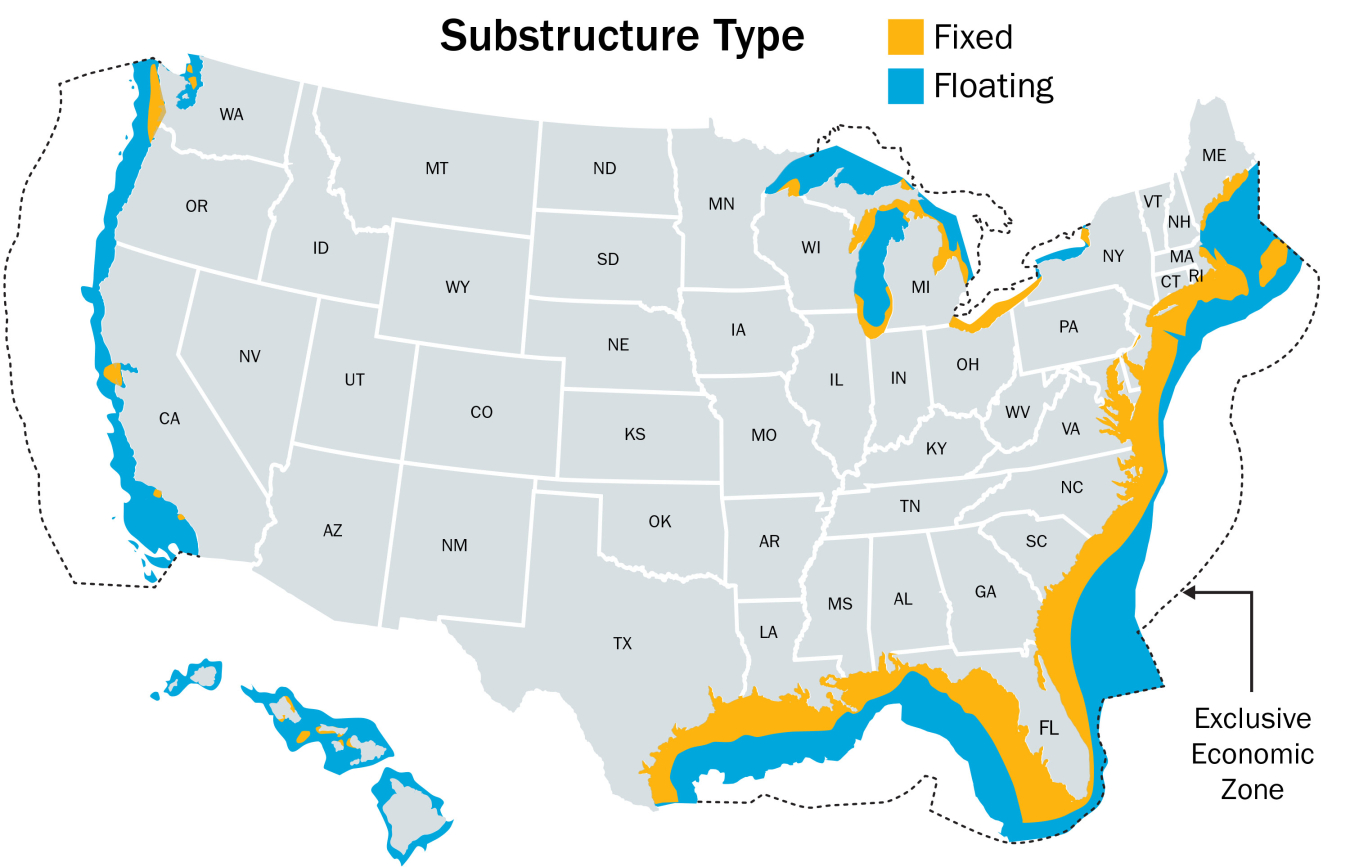
This map shows the general locations of wind resources off the coast of the United States where fixed-bottom (yellow) and floating (blue) offshore wind energy turbines could be installed around the United States to generate clean, renewable energy for the U.S. grid. Data presented do not consider potential siting constraints but do include a maximum water-depth constraint of 1,300 meters.
This project supports the interagency Floating Offshore Wind Shot™, which seeks to reduce the cost of floating offshore wind energy by 70% by 2035. Investments in floating offshore wind energy will help usher in America’s clean energy future by tapping into 2.8 terawatts of potential power—more than double the current U.S. electricity consumption.
Wind energy experts from Pacific Northwest National Laboratory (PNNL) reviewed 13 existing studies that focused on the technical evaluation of offshore wind energy transmission through potential points of interconnection along the coastlines of California, Oregon, and Washington.
The analysis—a companion study to one performed previously for the Atlantic Coast—also took into consideration existing and emerging state policies and BOEM wind site lease activities, including the recent California lease sale and buoy study off the coast of California. It was also informed by an ongoing PNNL analysis of southern Oregon and northern California offshore wind power transmission.
Findings and Next Steps
In the resulting West Coast Offshore Wind Transmission Literature Review and Gaps Analysis report published in February 2023, the researchers identified gaps that must be addressed to fully and successfully develop offshore wind energy off the nation’s West Coast. Many of these themes hold broader relevance to the evolution of transmission systems for the delivery of increasing amounts of renewable energy
“First, we found that the points of interconnection for the West Coast, particularly in key regions with robust wind resources, are limited in number. And onshore transmission capacities for integrating offshore wind power with the grid are not clear,” said Travis Douville, the PNNL renewable energy researcher who led the study. “Developing offshore wind energy needs to begin on land. That means the wind industry needs near-term targeted land–based infrastructure upgrades and technologies to prepare the existing grid for power flows from the ocean to the coast.”
Wind farms on the west coast, likely located 15-50 miles offshore, could increase the reliability and resiliency of the grid in multiple ways. When the wind is blowing, offshore wind power flows directly onto the grid to support homes, farms, and cities. Some of the electricity generated during this phase could be stored in onshore batteries for future use.
When the wind stops, the batteries power onshore communities.
Coordination of multiple power plants across multiple points of interconnection also affords flexibility of power delivery, which may be valuable in case of outage of a generation or transmission asset or price advantages due to line congestion or load increases on the broader transmission system.
The team identified challenges that need to be addressed to bring offshore wind energy onto the grid, including establishing viable cable routes to connect offshore wind projects to power substations.
“The designs of wind plant collector systems*, substations, and offshore transmission systems haven’t been clearly established for floating offshore wind sites on the West Coast,” Douville said. “We also found that only a handful of the studies addressed challenges with transmission cables, including seafloor depth and slope, seismic and gas-venting hazards, and considerations for environmental permitting.”
What else was missing? Connections between offshore wind energy development and West Coast electricity providers. Transmitting electricity in the western United States West has been characterized by long-distance, high-capacity transfers of electricity between regions. As more renewable energy is developed off the coasts of western states, similar coordination among electricity providers will be needed.
“Coordination across regions will shape how offshore wind power flows through the system, and it’s a critical component to decarbonization in the West” said Douville. “Joint planning between regions will also allow for the operation of offshore wind transmission during increasingly common, high-impact events, such as extreme heatwaves and wildfires.”
The team also explored whether technological, societal, or economic considerations were included in existing transmission studies.
“Techno—as well as socio-economic—feasibility will influence West Coast offshore wind development,” said Douville. “Analyses by the wind industry when developing offshore wind energy transmission should include social, cultural, environmental, and economic impacts to coastal and ocean co-use communities. This information has been absent in the literature, and it is impactful to the identification of the most beneficial and viable designs for future deployment efforts.”
“Ultimately, the identification and subsequent resolution of these gaps will be key to guiding future offshore wind energy research, planning, and development activities on the West Coast,” Douville said. “Beyond our analyses, we recommend further collaborations to fully inform offshore wind development decisions and accelerate the deployment of offshore wind.”
Following this project, WETO and DOE’s Grid Deployment Office launched the West Coast Offshore Wind Transmission Study, led by PNNL and the National Renewable Energy Laboratory. The findings from this study will help transmission planners and owners develop plans through 2050. These plans aim to address transmission constraints that currently limit offshore wind development in the deep waters of the Pacific Ocean while supporting grid reliability, resilience, and ocean co-use.
* A collection of wind turbines delivering energy to substations.
Subscribe to the WETO e-newsletter to stay informed on the latest wind energy news, events, publications, and updates.


